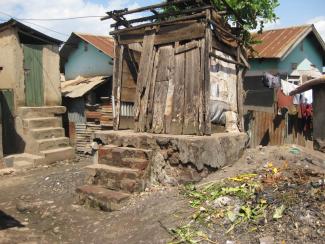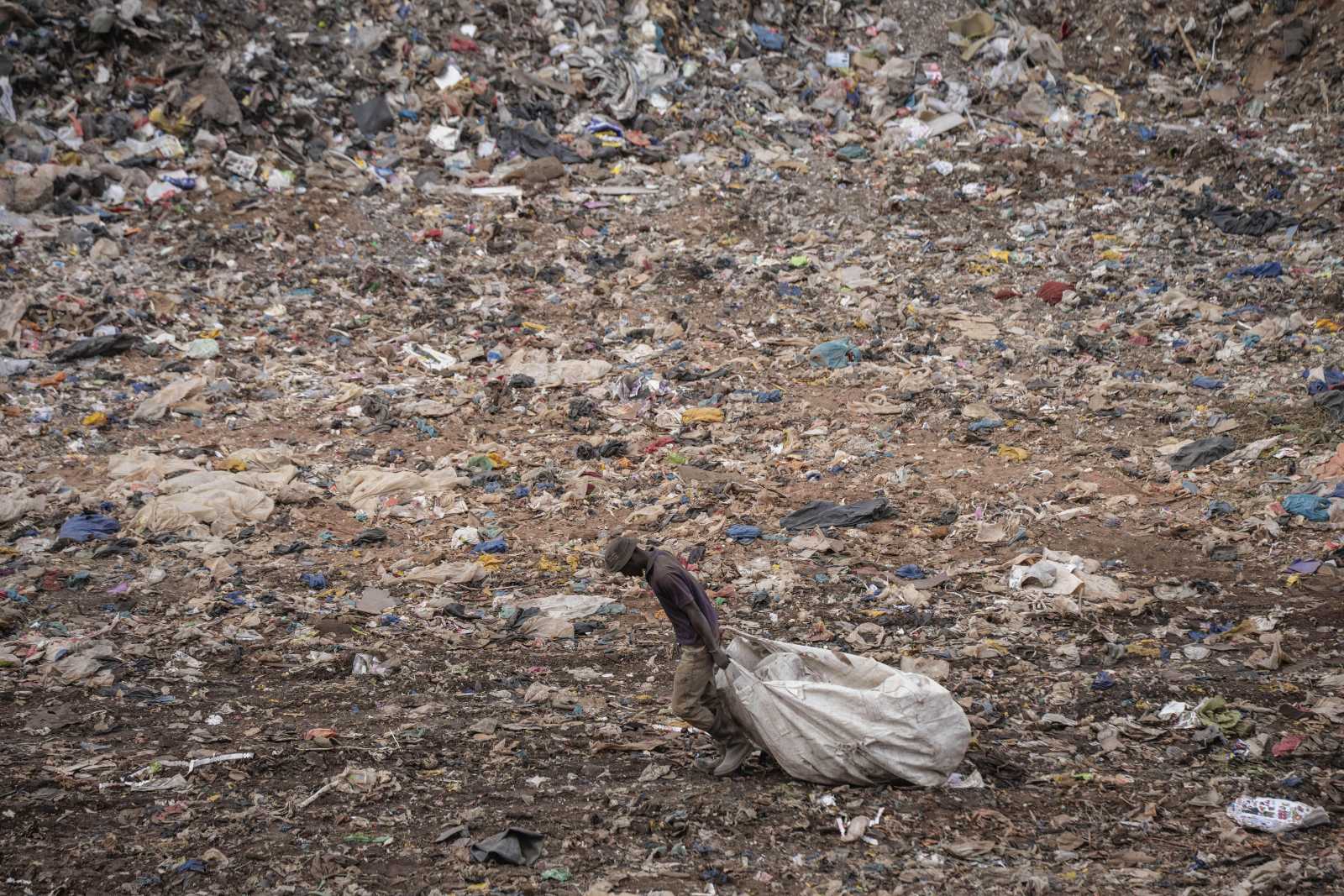Sanitation
Access to better toilets

An estimated 2.5 billion people – more than a third of the world population – lack access to improved sanitation facilities. Coverage is especially low in Sub-Saharan Africa (30 %). Most countries in the region will miss the Millennium Development Goal of halving the number of people without access to proper sanitation in the time span 1990 to 2015.
Inadequate sanitation is of particular concern in the fast growing cities of sub-Saharan Africa. Health hazards related to poor hygiene and improper disposal of human waste are greatest in densely-populated low-income settlements.
In most advanced nations, municipal governments are in charge of city-wide sewage infrastructure. However, sub-Saharan agglomerations tend to lack such centralised sewage systems which are the backbone of sanitation in rich nations.
Accordingly, "on-site" household sanitation technologies, such as ventilated and improved pit latrines, are considered the best technologies for African cities (Tilley et al 2008). These solutions do not require centralised infrastructure. Accordingly, many African cities rely on private investment by households to increase access to sanitation.
The downside of leaving sanitation to private initiative is that poor people, who face greater limitations to invest adequately, are left out. In fact, sanitation coverage remains low in slums. Until governments rise to the challenge of building city-wide infrastructure, the least they must do is draft policies for expanding private investment in on-site household sanitation.
In Kampala, a research project was conducted on the matter. It assessed sanitation demand and feasible options to boost private investments. The project was called Urban Affordable Clean Toilets (U-ACT). It was led by the Centre for Development and Cooperation at the Swiss Federal Institute of Technology Zurich (NADEL-ETHZ) and funded by the EU Water Initiative. Cooperating partners included the Swiss Aquatic Research Institute – Department of Water and Sanitation in Developing Countries (SANDEC-EAWAG), the Department of Civil Engineering of Uganda’s Makerere University, and the Ugandan non-governmental organisation Sustainable Sanitation and Water Renewal Systems (SSWARS).
The need
To understand the sanitation situation in Kampala’s poorest neighbourhoods, U-ACT conducted a representative survey of 1,500 randomly selected slum households in 2010. It turned out that 99 % of these households had access to some sort of sanitation facility. However, only 16 % had technologically improved sanitation facilities of their own. The great majority (84 %) had to rely on latrines that on average were used by five households with more than 20 individual persons. The data also showed that the cleanliness of toilets depended on how many people used them. If only one family used a toilet, it was most likely to be clean. If, however, more than four households used the same facility, it was likely to be dirty.
The survey also revealed that 70 % of Kampala’s slum dwellers are tenants who pay housing rents to a landlord. While tenants and landlords equally appreciate sanitation, tenants are much less likely to have access to improved (private) sanitation than the house owners (five percent versus 40 %). The major reason was differences in property rights. Those who own real estate can build toilet facilities, those who do not, cannot.
Another result was that the construction of improved pit latrines is quite expensive in relation to what people earn. An up-to-date latrine costs the equivalent of $ 750, which is about 50 % of the median annual household income of Kampala’s poor. Thus, while many poor people are willing to invest in sanitation in principle, the costs far exceed what they can actually afford.
Policy options
In 2011 and 2012, U-ACT implemented a randomised controlled trial (RCT) with 1,200 households in 40 slum communities to test various policy options. In an RCT, different households are assigned different policy measures, and the impact is analysed. The goal is to get a clear picture of what works best. To our knowledge, this was the first RCT on sanitation demand in a poor urban context.
In some places, U-ACT tested the impact of a pure social-marketing campaign which raised awareness of the benefits of improved sanitation but did not support people to invest. In other places, U-ACT tested what happens when the investment costs for improved sanitation are reduced. Vouchers with different levels of subsidies were handed out to different participant groups respectively. In yet other places, payment modalities were tested. Some households had to pay for the entire latrine a week before it was built. In other slum areas, households were given the option of a microcredit over 18 months at an interest rate of 20 %.
In the context of the U-ACT project, more than 150 ventilated improved pit latrines were built in 2012. They now serve more than 1,500 people. The assessment of the data indicated that a simple social-marketing campaign does not make poor households invest in sanitation.
The costs proved to be the crucial constraint. Accordingly, it was not surprising that people were the more likely to invest the less they had to pay. A very interesting result, however, was that offering households a microcredit for 18 months at 20 % interest rate had the same effect in terms of boosting demand as reducing investment costs by 25 %.
The RCT also analysed differences between home owners (30 % of Kampala’s slum population) and tenants (70 % of Kampala’s slum population). Home owners can invest in latrines since the land they need belongs to them. Tenants, however, cannot invest themselves. They must convince their landlords of doing so. Tenants were therefore asked to hand the distributed voucher to their landlord. In other words, the RCT did not only test the effects of social marketing, different price levels and the microcredit option, but the RCT also tested the impact of targeting different groups. The results show that it is much less promising to offer reduced prices to tenants because the members of this target group cannot decide on sanitation investments for themselves but have to convince their landlords of doing so. At all price levels, house owners that were directly approached by U-ACT were almost three times more likely to invest in sanitation than house owners that were approached by their tenants.
Overall, the U-ACT project provides evidence-based policy recommendations that are relevant to policymakers and development agencies beyond Uganda. The three most important are:
- It is not necessary to fully subsidise private latrine construction. It will often make more sense to use microcredit and allow poor households to pay for latrines in instalments over many months.
- Targeting matters, since it is more promising to approach home owners, who have decision power, than tenants.
Public regulations and enforcement are needed to ensure improved sanitation access for poor tenants who are dependent on landlords for sanitation investments.
These findings mean that private sanitation is feasible in slums if households’ credit constraints and land-tenure problems are taken into account. Sanitation policies, however, must deal with these two challenges.
In order to reach policymakers and researchers alike, the U-ACT project has not only written academic papers but has also engaged in a number of different activities to disseminate its results: the project has produced a project website (http://www.nadel.ethz.ch/forschung/u-act) with several policy briefs. A project video (http://www.youtube.com/watch?v=qJn7oFnSQWA) with relevant project results is also available.
Isabel Günther is an assistant professor at the Swiss Federal Institute of Technology in Zürich (ETHZ).
guenther@nadel.ethz.ch
Alexandra Horst is a PhD student at the same university.
horst@nadel.ethz.ch













